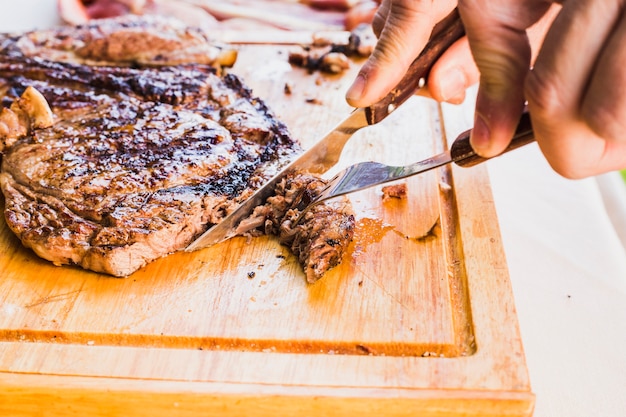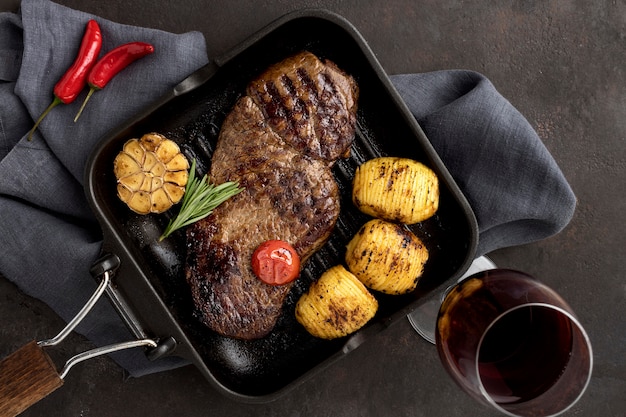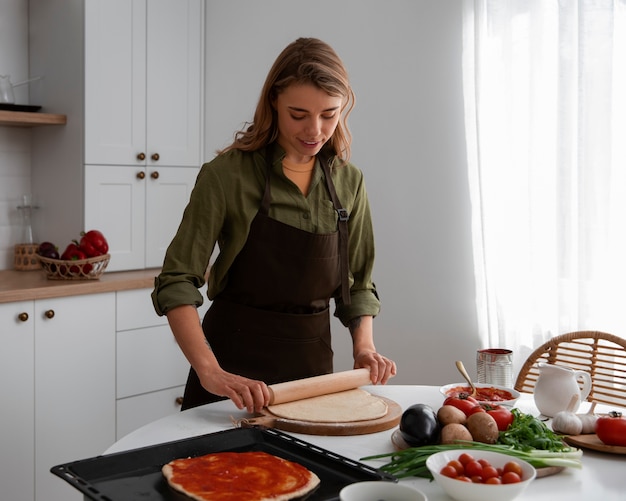Let's be honest, there's nothing quite like sinking your teeth into a perfectly cooked steak. That beautiful sear, the juicy, pink interior, the melt-in-your-mouth texture - it's pure culinary bliss! But achieving that steak nirvana can feel like a bit of a gamble, especially if you're not a seasoned grill master. I've been there, staring at a hunk of meat with a mix of excitement and trepidation, wondering if I'll end up with a dry, tough piece of disappointment. But fear not, my friends! I've learned a few tricks along the way, and I'm ready to share them with you. This guide is your ticket to consistently perfect stovetop steaks, no matter your skill level. So grab your trusty pan, a good bottle of red, and get ready to elevate your dinner game!
(Part 1) The Secret Sauce: choosing the right cut

The journey to steak perfection starts with choosing the right cut. I'll admit, I used to be a bit intimidated by the butcher's counter, feeling like I was walking into a meat-based jungle. But trust me, it's simpler than you think. The key is understanding what each cut offers and what you're looking for in your steak. You want a cut that's going to play nice with your cooking method and your taste preferences. Think of it as finding the perfect dance partner for your culinary adventure!
The Steak Spectrum: Understanding Your Options
Let's break down the most popular steak cuts, from the lean and flavorful to the marbled and decadent. Each one has its own unique personality and culinary strengths:
- Ribeye: This is the king of the steak world, known for its rich marbling, which translates into incredible flavor. Imagine a symphony of juicy, savory notes that will leave you singing its praises. It's the perfect choice for a special occasion or when you want to indulge in a seriously delicious meal. Think of it as the luxurious option, but be prepared for a bit more fat, which adds to its decadent nature.
- new york strip: A close contender to the ribeye, the New York strip boasts a more pronounced flavor and a slightly leaner profile. It offers a good balance of flavor and tenderness, making it a great all-around choice. It's a steak that knows how to hold its own, with a robust personality that will make a lasting impression.
- Sirloin: This is a versatile and affordable cut, offering a more lean and delicate flavor. It's perfect for those who prefer a lighter steak experience. It's a bit more approachable, with a subtle yet satisfying flavor that's easy to love.
- filet mignon: The epitome of elegance, filet mignon is renowned for its tender, buttery texture and mild flavor. It's the ultimate indulgence, often served in smaller portions, but be prepared for a higher price tag. It's a steak that whispers sophistication, with a delicate touch that melts in your mouth.
Your Steak Goals: Matching the Cut to Your Preferences
Think about what you want from your steak. Are you craving a juicy, marbled experience? Or are you looking for a leaner, more flavorful option? Once you know your desired flavor profile, you can choose the cut that best suits your needs. For instance, if you're after a juicy, decadent meal, a ribeye or New York strip is the way to go. But if you prefer a leaner steak with a bit more bite, a sirloin or a flank steak would be perfect. Don't be afraid to explore the different cuts and find the ones that speak to your culinary soul.
(Part 2) Prep Like a Pro: The Foundation of a perfect steak

Now that you've got your chosen cut, it's time to get ready for the starring role - prepping your steak! This might seem simple, but trust me, these steps are the backbone of a successful steak experience. It's like getting your actor ready for their big scene - we want them to shine!
The Art of Resting: Letting Your Steak Breathe
Before you even think about the pan, let your steak rest at room temperature for at least 30 minutes. This allows the meat to come up to temperature, ensuring even cooking and preventing a cold center. Remember, a chilled steak will cook unevenly and potentially become tough. Imagine trying to bake a cake straight from the fridge - it wouldn't turn out so well! So, let it relax and get ready for its close-up!
Seasoning Savvy: A Simple Approach for Maximum Flavor
I'm all for fancy rubs and marinades, but honestly, a simple seasoning approach often delivers the most delicious results. Salt and pepper are the ultimate duo, highlighting the natural flavors of your steak. Think of them as the best friends who bring out the best in each other. I like to season generously on both sides, making sure to coat the entire surface. Now, I'm not talking about burying the steak in salt, just a good, even layer. And don't forget to season both sides! This ensures that the entire steak gets that perfectly balanced flavor.
Don't Forget the Oil: The Key to a perfect sear
Just before hitting the pan, brush your steak with a thin layer of oil. This will create a beautiful sear and help prevent sticking. I prefer to use a neutral oil like canola or grapeseed, as they have a high smoke point and won't interfere with the steak's flavor. Think of it as giving your steak a little bit of protection and a helping hand in creating that gorgeous crust. Oil is your best friend in this department!
(Part 3) The Sizzling Showdown: Pan-Frying Perfection

Alright, here's the moment you've been waiting for - the pan-frying showdown! This is where the magic happens, where a simple piece of meat transforms into a culinary masterpiece. But before you toss that steak in the pan, let's get a few important details down. We want to make sure you're fully prepared for this sizzling showdown!
Heat is Your Friend: Get That Pan Sizzling
The secret to a perfect sear? High heat! You want your pan piping hot before adding the steak. If you can't hold your hand over the pan for more than a second, you're good to go. The goal is to create a nice, crispy crust without overcooking the inside. Imagine a chef's kiss for your steak! You can use a cast iron pan for maximum heat retention, or a heavy-bottomed stainless steel pan will work just fine. Both will be your trusty sidekicks in creating that perfect sear.
The One-Minute Rule: Searing Mastery
Once your pan is screaming hot, add your steak and resist the urge to touch it! Let it sear undisturbed for at least one minute, allowing the bottom to develop a beautiful golden-brown crust. Then, carefully flip it over and repeat on the other side. I know it's tempting to constantly peek and fidget, but trust me, patience is key here. The initial sear is what gives your steak its depth of flavor and that crispy, satisfying exterior. Think of it as the foundation for a truly delicious experience.
The Art of the Flip: A Gentle Touch
When you do flip your steak, avoid using a fork. Forks can pierce the meat, releasing precious juices and making your steak tough. Instead, use tongs to gently lift and turn your steak, making sure to maintain a nice, even sear on both sides. It's all about that beautiful golden-brown color, so keep an eye on it! We want to make sure every side of your steak gets a chance to shine!
(Part 4) The Temperature Game: A Guide to Cooking Perfection
Now that you've got that gorgeous crust, it's time to tackle the interior. This is where things get a little more nuanced, but fear not, I've got you covered with a simple guide to achieve the perfect level of doneness. This is where you really get to customize your steak experience - it's like choosing the perfect temperature for a warm bath!
The internal temperature: Your Steak's Secret Language
The best way to gauge the doneness of your steak is to use a meat thermometer. This little tool is your secret weapon for consistent results, eliminating any guesswork. Think of it as a translator for your steak, telling you exactly what it's feeling on the inside. Here's a quick breakdown of the internal temperatures for different levels of doneness:
| Doneness | Internal Temperature (°F) |
|---|---|
| Rare | 125-130°F |
| Medium Rare | 130-135°F |
| Medium | 140-145°F |
| Medium Well | 150-155°F |
| Well Done | 160°F and above |
Timing is Everything: The Steak's Internal Clock
If you're not using a thermometer, here's a general guideline for cooking times:
- Rare: 2-3 minutes per side
- Medium Rare: 3-4 minutes per side
- Medium: 4-5 minutes per side
- Medium Well: 5-6 minutes per side
- Well Done: 6-7 minutes per side
Remember, these are just guidelines. The actual cooking time will vary depending on the thickness of your steak and the heat of your pan. So, keep a close eye on your steak and use a thermometer to ensure it reaches your desired level of doneness. It's all about finding that sweet spot for your steak!
(Part 5) The Final Act: Rest and Serve Your Steak
You've seared, you've cooked, and now it's time for the grand finale - resting your steak. This crucial step allows the juices to redistribute, ensuring a tender, juicy steak that melts in your mouth. It's like giving your steak a chance to catch its breath and regain its composure after a whirlwind of culinary action.
Let It Rest: The Key to Juicy Bliss
After removing your steak from the pan, place it on a cutting board and let it rest for 5-10 minutes. I know it's tempting to dig in right away, but trust me, patience is your reward. During this rest period, the internal temperature will continue to rise slightly, and the juices will redistribute evenly throughout the steak. This ensures a tender, juicy bite with every cut. Imagine a symphony of flavors that explode in your mouth - pure culinary delight!
Slice and Dice: A Showstopping Presentation
Once your steak has rested, it's time to slice and dice for a visually appealing presentation. I like to cut my steak against the grain, creating tender, flavorful bites. Think of it as a culinary dance, where each slice is a harmonious movement of flavor and texture. If you're serving your steak with sides, arrange them artfully on the plate for a balanced and visually pleasing presentation. The final touch - a masterpiece ready to be enjoyed!
(Part 6) Beyond the Basics: Elevating Your Steak Game
Now that you've mastered the fundamentals, let's explore some advanced techniques and flavor-boosting additions to truly elevate your steak game. It's time to level up your skills and become a true steak connoisseur!
reverse searing: The Secret to a Perfectly Even Steak
For those who prefer a more even level of doneness throughout, reverse searing is a fantastic technique. This method involves cooking the steak at a low temperature for an extended period before finishing with a quick sear. The result is a steak that's incredibly tender and juicy, with a beautifully crisp crust. It's like giving your steak a spa treatment - slow cooking to achieve ultimate tenderness, followed by a final burst of heat for a delicious crust. To reverse sear, preheat your oven to 275°F and place your seasoned steak on a wire rack over a baking sheet. Cook for about 30 minutes for a medium-rare steak, adjusting the cooking time based on the thickness of your steak and your desired level of doneness. Once the steak reaches your desired internal temperature, remove it from the oven and sear it in a hot pan for 1-2 minutes per side. This final sear will give you that delicious crispy crust while maintaining the tender, juicy interior. It's the perfect combination of science and culinary artistry!
Flavor Fusion: The Art of Marinades and Rubs
While salt and pepper are a classic combination, don't shy away from experimenting with marinades and rubs to infuse your steak with extra flavor. I love using a simple marinade of olive oil, lemon juice, garlic, and herbs. You can also get creative with your rubs, incorporating spices like paprika, cumin, chili powder, or even a touch of sweetness with brown sugar. Just remember to apply the marinade or rub at least 30 minutes before cooking to allow the flavors to penetrate the steak. Think of it as giving your steak a flavorful makeover, transforming it into a culinary masterpiece.
(Part 7) Steak Sidekicks: Complementary Companions for Your Meal
No steak is complete without its supporting cast - the delicious sides that make the meal truly memorable. Here are some classic and innovative pairings that complement the flavors of your perfectly cooked steak. Think of them as the perfect dance partners for your steak, adding depth and dimension to your culinary experience!
Classic Combinations: A Time-Tested Duo
Nothing beats the classic pairing of steak and mashed potatoes. The creamy texture of the potatoes contrasts beautifully with the juicy tenderness of the steak, creating a satisfying and comforting meal. For a touch of indulgence, add a dollop of butter or a sprinkle of chives. It's a classic for a reason - a perfect blend of textures and flavors! Another classic combo is steak and asparagus. The crisp, green spears provide a vibrant counterpoint to the richness of the steak, and their light, vegetal flavor complements the savory notes of the meat. Simply roast the asparagus until tender-crisp, and drizzle with a light dressing or a squeeze of lemon juice. A perfect balance of earthy and fresh!
Beyond the Basics: Creative Sides for Steak
If you're looking for something a bit more adventurous, try pairing your steak with roasted vegetables like Brussels sprouts, carrots, or sweet potatoes. The caramelized sweetness of these vegetables adds another layer of flavor to your meal, while their textures create a delightful contrast. Think of it as an explosion of culinary creativity! For a lighter option, try a salad with a tangy vinaigrette. The acidity of the dressing cuts through the richness of the steak, adding a refreshing element to your meal. A perfect way to end your steak adventure on a light and refreshing note!
(Part 8) FAQs: Your Steak Questions Answered
1. What temperature should my pan be for a perfect sear?
You want your pan piping hot! It should be hot enough that you can't hold your hand over it for more than a second. This high heat ensures a beautiful, crispy crust without overcooking the inside. It's all about finding that perfect balance of heat and timing.
2. How do I know when my steak is done?
The best way to determine doneness is with a meat thermometer. It's the most reliable way to ensure your steak is cooked to your exact preferences. Think of it as a secret code, revealing the true state of your steak's heart. However, if you're not using a thermometer, you can use the time-based guidelines provided earlier, but keep in mind that cooking times can vary based on steak thickness and pan heat. It's all about finding that sweet spot for your steak!
3. What if my steak is too thick?
If your steak is too thick, consider using a combination of pan-frying and oven cooking for a more even cook. Sear the steak in a hot pan for a couple of minutes per side, then transfer it to a preheated oven to finish cooking to your desired doneness. It's like a relay race for your steak, ensuring it gets the perfect combination of heat and time.
4. Can I cook multiple steaks at once?
Yes, you can! Just make sure you have a pan large enough to accommodate all the steaks without overcrowding. This will help ensure even cooking and prevent the steaks from steaming instead of searing. Think of it as a steak party - everyone needs their own space to shine!
5. What's the best way to store leftovers?
Refrigerate leftover steak in an airtight container for up to 3-4 days. You can reheat it gently in the oven or microwave. Avoid reheating steak at a high temperature, as this can dry it out. Think of it as giving your steak a gentle second chance to shine!
There you have it, your complete guide to stovetop steak perfection! Remember, practice makes perfect, so don't be afraid to experiment and find what works best for you. Happy grilling, and enjoy that juicy, flavorful steak!
Everyone is watching

Perfect Rice Every Time: The Ultimate Guide to Cooking Rice
Cooking TipsAs a self-proclaimed foodie, I've always been a bit obsessed with rice. It's the foundation of countless cuisi...

Prime Rib Roast Cooking Time Chart: Per Pound Guide
Cooking TipsPrime rib roast. Just the name conjures images of lavish dinners, crackling fires, and hearty laughter. It’s ...

How Long to Bake Potatoes in the Oven (Perfect Every Time)
Cooking TipsBaked potatoes are a staple in my kitchen. They're incredibly versatile, delicious, and surprisingly easy to m...

The Ultimate Guide to Cooking Asparagus: Tips, Techniques, and Recipes
Cooking TipsAsparagus. The mere mention of this spring delicacy conjures up images of vibrant green spears, crisp and burs...

Ultimate Guide to Cooking the Perfect Thanksgiving Turkey
Cooking TipsThanksgiving. Just the word conjures up images of overflowing tables laden with delicious food, the scent of r...
